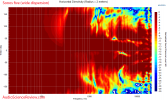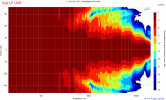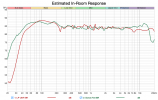In theory, Klippel NFS doesn't care what the sound source looks like, nor does it make any assumptions about it. You can have a thousand drivers pointing in any direction and it could quantify it.
As a practical matter, the more complex the soundfield, the more samples you need to make to maintain high accuracy. I use about 1000 points which was sufficient to achieve high accuracy (less than 1% error) up to about 10 kHz. How do I know this? Klippel NFS makes redundant measurements which it then uses to compare those actual measurements against the computed ones. So the error is known. The actual error on axis is actually quite small above 10 kHz. It is the off axis which suffered more.
Quick question about the Klippel. When it gives us an "anechoic response" what exactly does that mean? I see it says on axis with the tweeter, but at what distance? One thing that's been on my mind is that more directional signals have a slower fall off rate with distance, so unless the directivity is the same across the spectrum, the on-axis will change with distance. With any changing directivity the speaker there will only be one distance with a flat anechoic response on-axis. I've been reminded of this as I attempt to move further from my CD horns and remove reflections with windowing, I see the response curve that was equalized perfectly flat at 1 meter on axis increasingly can be seen drooping on the low end with distance if the windowing is narrowed to minimize reflected energy in the room.
Edit: I think I just need to read CEA-2034 standard noted on the graph and that will probably answer everything. I found this already, which addresses my question and the concerns it raised as I try to adjust my speakers for my listening position. A speaker should state the distance where it's anechoic on-axis response is expected to be ideal. This leads me to wonder if it may be appropriate to re-equalize the speaker for various listening distances. It makes sense that the closer you get, the less it matters what's going on off axis, so it may be more prudent to eq to keep the on-axis anechoic flat at that distance.
"Ideally measurements should be made in the far field of the DUT and, for reasons of standardization the sensitivity should be referenced to a distance of 1 m. The far field for large diaphragm loudspeakers can be several meters away and listeners may sit in the near field of these loudspeakers."



